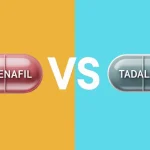Introduction:
In today’s world, cognitive enhancers like Modafinil and Vyvanse have gained popularity among students, professionals, and individuals with ADHD. Both medications improve focus and productivity, but they work in fundamentally different ways. In this details blogpost we would go over different aspects of both the medications and at the same time we will compare them (modafinil vs vyvanse)
Modafinil vs Vyvanse: An Overview
Vyvanse is the brand name for a drug called Lisdexamfetamine. It works as a stimulant for the central nervous system and changes some chemicals in the brain that impact behavior and impulse control. Vyvanse is FDA-approved and primarily prescribed to help manage symptoms of Attention Deficit Hyperactivity Disorder (ADHD). In addition to improving focus and reducing impulsive behavior, it can also help people deal with related emotional and social challenges. However, it should never be used as a method to lose weight, as doing so can be harmful to your health.
Modafinil is a prescription drug classified as a Schedule IV controlled substance. The FDA approved Modafinil in 1998 for medical use. It belongs to a group of medications known as eugeroics, used to promote wakefulness.
This medication is known for its powerful stimulant properties and is mainly used to treat sleep-related disorders such as narcolepsy, obstructive sleep apnea, and shift work sleep disorder. For most adults, the usual dose is 200 mg per day, though the exact amount may vary depending on individual needs. The maximum safe dose is 100 to 200 mg per day. Taking more than recommended can result in an overdose and lead to unwanted side effects.
What is Modafinil?
Modafinil is a prescription medication approved by the U.S. Food and Drug Administration to enhance alertness in individuals with sleep disorders. The most common sleep disorders it is used for are sleep apnea, shift work sleep disorder, and narcolepsy.
Medical and Off-Label Uses
- Narcolepsy (excessive daytime sleepiness)
- Shift Work Sleep Disorder (for night-shift workers)
- Obstructive Sleep Apnea (as an adjunct treatment)
Off-Label, It’s used for
- Productivity enhancement (students, professionals)
- Jet lag recovery
- Cognitive decline support in certain conditions
How Modafinil Works?
Modafinil enhances alertness by:
- Increasing dopamine levels (improves motivation and focus)
- Activating orexin/hypocretin neurons (promotes wakefulness)
- Boosting histamine release (supports sustained attention)
Unlike traditional stimulants, it provides smooth, jitter-free energy.
Duration and Effects
- Onset: 30 – 60 minutes
- Peak effects: 2 – 4 hours
- Duration: 12 – 15 hours
- Typical dose: 100 – 200 mg
Pros:
Long-lasting focus without crashes
Low addiction potential (Schedule IV)
Minimal appetite suppression
Cons:
May cause headaches or dry mouth
Can disrupt sleep if taken late
Rarely, severe skin reactions (Stevens-Johnson syndrome)
Read: Modafinil- The Smart Drug for Enhancing Cognitive Performance
What is Vyvanse?
Vyvanse is the trade name for a drug called lisdexamfetamine. It is a prescription medication that is approved for use for ADHD and binge eating disorder.
Primary Uses
Vyvanse is a type of amphetamine, so there is a high risk of dependence with Vyvanse use it is quite powerful.
- ADHD (improves focus and impulse control)
- Binge Eating Disorder (reduces compulsive eating episodes)
Unlike Adderall, it is a prodrug, meaning it must be metabolized into dextroamphetamine—resulting in a smoother, longer-lasting effect.
How Vyvanse Works?
Vyvanse increases:
- Dopamine (enhances motivation and reward response)
- Norepinephrine (boosts alertness and attention)
This makes it highly effective for ADHD symptoms like distractibility and hyperactivity.
Duration and Effects
- Onset: 1 – 2 hours
- Peak effects: 3 – 4 hours
- Duration: 10 – 14 hours
- Typical dose: 30 – 70 mg
Pros:
Strong, laser-like focus
Helps with task initiation (common ADHD struggle)
Less abrupt comedown than Adderall
Cons:
Significant appetite suppression
May cause anxiety or irritability
Higher abuse potential
Modafinil vs Vyvanse: Key Differences
Modafinil and Vyvanse both enhance focus and alertness but differ in their mechanisms; Modafinil is often used for sleep disorders, while Vyvanse is primarily prescribed for ADHD.
How They Work Differently in Your Brain
These two medications take different approaches to boosting your focus and alertness. Modafinil works like a gentle but persistent alarm clock for your brain – it blocks dopamine from being reabsorbed too quickly (like keeping more fuel in your tank) while also activating orexin neurons that control your natural wakefulness cycles.
Vyvanse, in contrast, works like hitting the gas pedal on your brain’s reward system. After you take it, your body converts Vyvanse into dextroamphetamine, which floods your brain with dopamine and norepinephrine – these are your brain’s natural “focus and motivation” chemicals. The dopamine surge is why Vyvanse feels more powerful for concentration, but also why it carries more risk of side effects and dependence.
Prescription Rules and Accessibility
The U.S. government classifies these drugs very differently because of their potential for abuse:
Modafinil is Schedule IV, meaning:
- Doctors can prescribe it more freely
- Pharmacies can give refills
- Considered to have low potential for abuse
- Often prescribed for shift work or general fatigue
Vyvanse is Schedule II, meaning:
- Stricter prescription rules (no refills without new script)
- Higher potential for abuse/dependence
- Primarily prescribed only for ADHD or binge eating disorder
- Doctors monitor use more closely
This classification system explains why you’re more likely to get Modafinil prescribed for general focus issues, while Vyvanse is reserved for diagnosed ADHD cases. Some doctors may be hesitant to prescribe Vyvanse for cognitive enhancement due to its higher risk profile.
Side Effects of Modafinil and Vynanse: What to Expect?
After years of clinical use, clear patterns have emerged about how people react to each medication:
Modafinil’s side effects tend to be milder but can include:
- Headaches (about 1 in 5 users) – often helped by drinking more water
- Dry mouth (keep water handy)
- Occasional nausea when first starting
- Trouble sleeping if taken after noon (best taken early)
- Rarely, mild anxiety
Vyvanse often causes more noticeable effects:
- Significant appetite suppression (many users forget to eat)
- “Stimulant crash” in the evening (irritability/fatigue)
- Increased heart rate (5-10 bpm higher)
- Anxiety or overstimulation in some people
- Possible emotional blunting (feeling less social/emotional)
The “come down” from Vyvanse is much more noticeable compared to the gradual reduction of Modafinil’s effects. Many users of Vyvanse report feeling suddenly exhausted or irritable as the medication wears off, while users of Modafinil typically experience a return to focus without experiencing sharp fluctuations.
Addiction Risks and Long-Term Use
The potential for dependence differs significantly between these medications:
With Vyvanse:
- About 10-15% of regular users develop tolerance within a year
- May need dose increases over time to get the same effect
- Can cause psychological dependence (feeling you “need” it to function)
- Withdrawal can include fatigue, depression, and increased appetite
With Modafinil:
- Less than 5% develop tolerance with regular use
- Most people stay at the same dose for years
- Minimal withdrawal symptoms
- Much lower reports of psychological dependence
For students or professionals considering long-term use, Modafinil is generally the safer option. The brain adapts less to Modafinil over time, meaning it’s more likely to keep working at the same dose. Vyvanse often requires “medication vacations” – planned breaks to prevent tolerance buildup.
Which is better for Long-Term Use?
For chronic conditions requiring daily medication:
Modafinil shines for:
- Shift workers needing years of nighttime alertness
- People with chronic fatigue
- Long-term cognitive enhancement
- Those wanting to avoid tolerance issues
Vyvanse works better for:
- ADHD management (remains first-line treatment)
- Cases where stronger focus is needed
- Situations where appetite suppression might be beneficial
Both require doctor supervision, but Modafinil’s milder effects and lower risk profile make it the preferred choice for most people seeking long-term cognitive support. However, for diagnosed ADHD, Vyvanse’s strong effects often make it the more effective treatment despite the higher risks.
How to Choose the Right Medication for You
Picking between Vyvanse and Modafinil depends on your specific needs:
- For ADHD treatment, Vyvanse is typically more effective as it’s specifically designed to improve focus and impulse control.
- For sleep disorders like narcolepsy, Modafinil is better since it targets wakefulness without stimulation. Buy Modafinil Online
Keep in mind:
- Vyvanse may cause more noticeable side effects like appetite loss or jitters
- Modafinil tends to be gentler
- Both require a doctor’s prescription
Always consult your physician before making any changes to your medication regimen. They can help determine which option best fits your health needs and lifestyle.
FAQ’s
Modafinil is specifically to help people stay awake, making it more effective for sleep issues. Vyvanse can also help with wakefulness, but that is not its primary purpose.
No – Vyvanse gives a strong “kick” that helps with focus right away, while Modafinil feels more like drinking several cups of coffee that last all day without the jitters.
Vyvanse has a higher chance of addiction because it’s stronger. Modafinil is much less addictive, which is why doctors worry about it less.
Vyvanse usually causes more problems like:
- Not feeling hungry
- Trouble sleeping
- Feeling cranky when it wears off
Modafinil can cause headaches and may disrupt sleep if taken late.
Final Words!
For shift workers, students, or professionals seeking reliable cognitive support, Modafinil typically provides a better risk-benefit balance. Those with diagnosed ADHD may benefit more from Vyvanse’s targeted effects – but always under medical supervision. Ultimately, the choice depends on your specific needs and health profile. Consult your doctor to determine which option aligns best with your goals and medical history.



